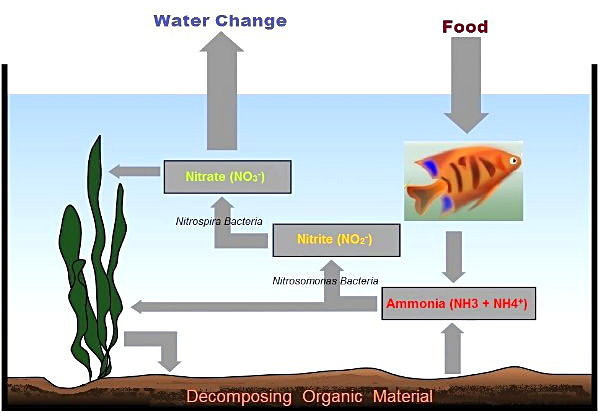You are not following the directions on this site for doing a fishless cyle. Nor are you following the directions for a fishkess cycle using One and Only on Dr. Tim's site either. Neither one of these directions suggests daily dosing of ammonia.
Ammonia does not affect the pH in a tank at the levels of fishless cycling and not because a tank is cycled. However, the cycle itself if acidic over time. This is due a small bit to nitrite and moreso to nitrate. In water they create acid. Nitrite creates some nitrous acid, which is a weak acid, nitrate creates nitric acid which is a stong acid. Additionally, the bacteria will use some of the carbonates and bicarbonates as their source of inorganic carbon. These are a big part of KH. As KH is used up, the buffering capacity it provides for pH lowers and this means the pH of the water can drop. Add acid now and down goes the pH.
Using Doctor Tim's properly (and assuming it was not killed by freezing or too much heat), it should take about a week, give or take a couple of days, to cycle a tank to hold full stocking.
The thing that most often stalls a cycle is to much nitrite. This is caused by too much ammonia. If you add up all the doses of ammonia listed in the fishless cycling article on this site, you will see it states that most people will get a tank cycled with between 6 and 7 additions of ammonia over about a 5 -6 week period. This assumes that no bacterial starter help is used and there are no live plants in the tank. If you look at the graph of the average cycle in the article here, you will see ammonia spends a fair amount of time at 0 ppm.
I can say for certain that if one follows the directions in the site article to the letter, one will get a tank cycled in the time frame given. If one uses Dr. Tim's One and Only and follows his directions to the letter, you will get a tank cycled in about a week. If you read his directions here,
https://www.drtimsaquatics.com/resources/library/quick-guide-to-fishless-cycling-with-one-and-only/ you need to be aware of the fact that he uses the
Nitrogen scale and most of us use the
Total Ion scale on our test kits. So when he suggests ppm numbers, one needs to convert them from the nitrogen to the total ion scale.
| NH3 = NH3-N * 1.21589 |
| NH4 = NH4-N * 1.28786 |
| NO2 = NO2-N * 3.28443 |
| NO3 = NO3-N * 4.42664 |
Since the ammonia in tanks is mostly NH4, I suggest using a multiplication factor of 1.280. That means where the article on this site is using 3 ppm using the total ion scaleas the basic ammonia dosing level, Dr. Tim's 2 ppm would be measured as 2.56 ppm. However, on this site the is no bacteria being seeded. And as to where the nitrite level stalls a cycle, Dr. H. says not to exceed 5 ppm (on the nitrogen scale) which would read about 16.4 ppm on most hobby test kits.
Dosing instructions are pretty clear for either here or on Dr. Tim's and are based solely on one's actual test results. I believe the ones here are the clearer of the two. But I am slightly biased. Incidentally, the cycling article here is loosely based on Dr. Tim's directions for doing one without his One and Only. The big difference is the one here uses the total ion scale and is altered such that one need not do diluted testing for nitrite as it cannot reach the cycling stall level as long as onefollows the ammonia dosing instructions.
One last piece of advice. There is a lot of noise on the net. If you are going to follow the directions on any site, then do not mis them with what you read elsewhere. this only makes things more confusing. You would not follow the directions for adding sugar to an apple pie if you were making a cherry pie, would you? The same applies to any cycling method.





